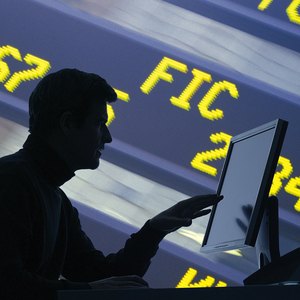
The National Association of Securities Dealers Automated Quotation system, or NASDAQ, was established in 1971 as a way to increase trading in over-the-counter stocks. These are stocks that are not able to meet the requirements to be listed on larger exchanges, such as the New York Stock Exchange (NYSE). The NASDAQ is an all-electronic exchange, and it does not have a physical trading floor. Around 3,300 stocks are trading on the NASDAQ as of publication, and it processes around 1.8 billion trades each day.
Tech Stocks
Many high-technology stocks trade on the NASDAQ, as well as other new companies that have high-growth and highly volatile stocks. New companies gravitate to the NASDAQ because the initial listing fees on NASDAQ tend to be lower than the fees to list on the NYSE. Tech stocks also tend to gravitate toward listing on NASDAQ because it was the first stock market in the U.S. to trade online. Many of the largest technology companies in the U.S., such as Apple, Google, Microsoft and Intel, list on the NASDAQ.
National Market Requirements
The NASDAQ actually has two national markets, the National Market and the SmallCap Market, renamed the Capital Market in 2005. To be listed on the National Market, companies must meet certain minimum requirements. When stocks are first listed, they must have a minimum bid price of $5 per share. Once listed, the price of the stock must remain at or above $1 per share. Any company listed on the National Market must have net tangible assets of $6 million or more and a net yearly income of at least $1 million. Companies also need a public float valued at $8 million or higher and at least 400 shareholders. Some companies are allowed to list on NASDAQ without meeting these requirements, if they have a market capitalization, total assets or total revenues of at least $75 million and an initial bid price of $5 per share.
Market Makers
All stocks sold on the NASDAQ must have at least three market makers. A market maker is a stock brokerage firm that represents particular stocks. Market makers buy and sell these stocks on behalf of investors and often specialize in particular types of stock. For example, a market maker may specialize in trading aerospace stocks. There are around 500 market makers for the NASDAQ. Market makers may deal with individual investors or institutional investors, such as pension funds and mutual funds.
Capital Market
Companies that do not meet the requirements for the NASDAQ National Market, can list on the Capital Market. These stocks must also meet certain requirements. These include having net tangible assets of $4 million, a market capitalization of $50 million or a net income of $750,000. Stocks listed on the NASDAQ Capital Market also must have at least 300 shareholders, a minimum bid price of $4 and an initial public float of at least $1 million. Once listed, these stocks must maintain a bid price of at least $1.
References
- NASDAQ: NASDAQ Listing Qualifications
- Dummies: How the Nasdaq Works; Amine Bouchentouf, et al.
- ADVFN: NASDAQ
- Nasdaq. “NYSE May Be Bigger, But Nasdaq Is Growing Faster.” Accessed July 28, 2020.
- Nasdaq. "About Nasdaq." Accessed July 28, 2020.
- Nasdaq. “Quotes for NASDAQ-100 Index.” Accessed July 28, 2020.
- Nasdaq Nordic. “About Us.” Accessed July 28, 2020.
- Nasdaq. “Nasdaq Equity Indexes.” Accessed July 28, 2020.
- Nasdaq. ”Form 10-K, Nasdaq, Inc.,” Page F-9. Accessed July 28, 2020.
- Nasdaq. "What Time Does the Stock Market Open and Close?" Accessed July 28, 2020.
- Nasdaq. “Initial Listing Guide,” Page 3. Accessed July 28, 2020.
- Nasdaq. “Initial Listing Guide,” Pages 6-12. Accessed July 28, 2020.
- Nasdaq. "Nasdaq Total Returns." Accessed July 28, 2020.
Writer Bio
Since graduating with a degree in biology, Lisa Magloff has worked in many countries. Accordingly, she specializes in writing about science and travel and has written for publications as diverse as the "Snowmass Sun" and "Caterer Middle East." With numerous published books and newspaper and magazine articles to her credit, Magloff has an eclectic knowledge of everything from cooking to nuclear reactor maintenance.

